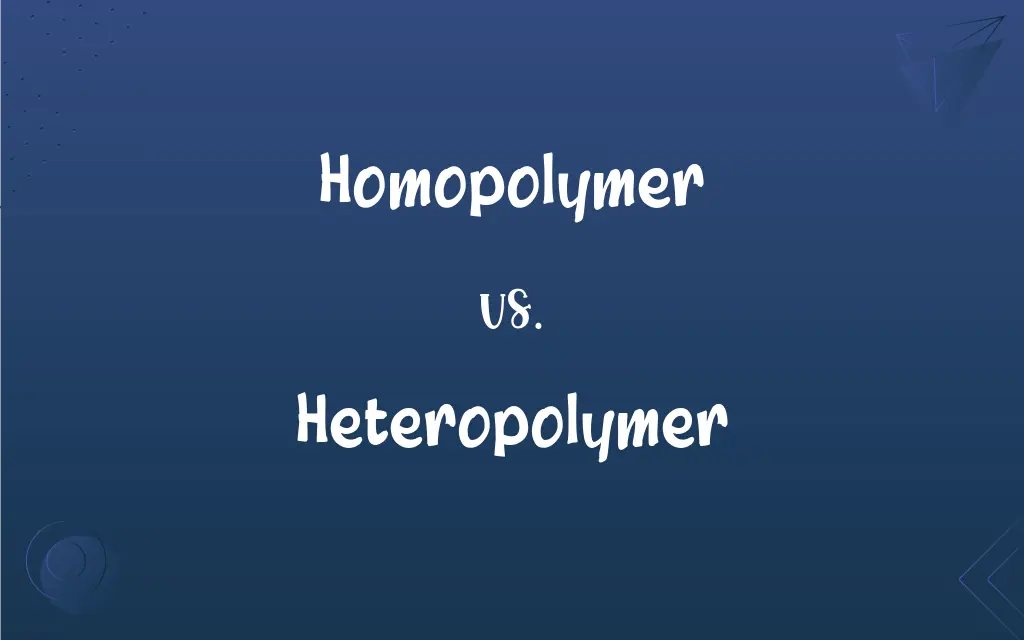Homopolymer vs. Heteropolymer: What's the Difference?
Edited by Aimie Carlson || By Harlon Moss || Published on February 15, 2024
Homopolymers are made of one type of monomer, while heteropolymers consist of different types of monomers.

Key Differences
A homopolymer is a polymer made from a single type of monomer, leading to a uniform molecular structure. In contrast, a heteropolymer consists of two or more different kinds of monomers, resulting in a varied molecular structure.
Homopolymers exhibit consistent properties throughout due to their uniform composition. Heteropolymers, however, have diverse properties that reflect the different monomers in their composition.
In terms of complexity, homopolymers are simpler due to their repetitive units. Heteropolymers are more complex, with the variation in monomers leading to a broader range of functionalities.
The physical and chemical properties of homopolymers are more predictable and uniform. Heteropolymers offer a wider range of properties and can be tailored for specific applications due to their varied composition.
Homopolymers are often used in applications requiring consistent performance. Heteropolymers, with their versatile properties, are suited for more specialized applications requiring specific characteristics.
ADVERTISEMENT
Comparison Chart
Monomer Composition
Single type of monomer
Multiple types of monomers
Molecular Structure
Uniform
Varied
Complexity
Simpler
More complex
Properties
Consistent and predictable
Diverse and adaptable
Typical Applications
General-purpose materials
Specialized materials
ADVERTISEMENT
Homopolymer and Heteropolymer Definitions
Homopolymer
Homopolymers are composed entirely of identical monomeric units.
Polystyrene, used in foam cups, is a homopolymer made from styrene monomers.
Heteropolymer
A heteropolymer is a polymer composed of two or more different kinds of monomers.
Proteins are heteropolymers composed of different amino acids.
Homopolymer
A homopolymer is a polymer derived from a single species of monomer.
Polyethylene, a common plastic, is a homopolymer made from ethylene monomers.
Heteropolymer
A heteropolymer consists of repeating units of different chemical structures.
Polyester, used in fabrics, is a heteropolymer of ethylene glycol and terephthalic acid.
Homopolymer
A homopolymer is a macromolecule composed of only one kind of monomer.
Nylon-6,6, a synthetic fiber, is a homopolymer made from hexamethylene diamine and adipic acid.
Heteropolymer
Heteropolymers are macromolecules with varied monomeric units in their chain.
Epoxy resins are heteropolymers made from epichlorohydrin and bisphenol-A.
Homopolymer
Homopolymers are polymers with a single type of monomeric unit in their composition.
Polypropylene, a packaging material, is a homopolymer of propylene.
Heteropolymer
A heteropolymer is a polymer with a diverse monomeric composition.
Polycarbonates, used in eyeglass lenses, are heteropolymers derived from bisphenol A and phosgene.
Homopolymer
A homopolymer consists of repeating units of the same chemical structure.
PVC (polyvinyl chloride) is a homopolymer made from vinyl chloride monomers.
Heteropolymer
Heteropolymers contain a sequence of multiple distinct monomeric units.
DNA is a heteropolymer made up of four types of nucleotides.
Homopolymer
(chemistry) a polymer formed from a single type of monomer
Heteropolymer
(chemistry) A polymer derived from two or more different (but often similar) types of monomer
FAQs
How are the structures of homopolymers and heteropolymers different?
Homopolymers have a uniform structure, while heteropolymers have a varied structure.
Can homopolymers be naturally occurring?
Yes, some natural polymers are homopolymers, like cellulose.
What defines a homopolymer?
A polymer made from only one type of monomer.
What is a heteropolymer?
A polymer consisting of two or more different types of monomers.
Are heteropolymers found in nature?
Yes, examples include proteins and DNA.
Can heteropolymers be designed for specific functions?
Yes, their varied composition allows for tailored functionalities.
How do homopolymers affect material performance?
They provide predictable and uniform performance.
What is an example of a synthetic homopolymer?
Polyethylene, a common plastic.
Can homopolymers be biodegradable?
It depends on the monomer; some synthetic homopolymers are not biodegradable.
Do homopolymers have consistent properties?
Yes, their properties are consistent due to their uniform composition.
Are heteropolymers more complex than homopolymers?
Yes, due to the variety of monomers in their composition.
What role do heteropolymers play in biology?
They are crucial for biological functions, like enzymes and structural components.
What are the typical uses of homopolymers?
They are used in general-purpose materials like plastics and fibers.
In what applications are heteropolymers used?
They are often used in specialized materials due to their diverse properties.
Are homopolymers always made from petrochemicals?
No, some are made from renewable resources like cellulose.
What impacts the recyclability of homopolymers and heteropolymers?
The complexity and composition of the polymers can affect their recyclability. Homopolymers are often easier to recycle due to their uniform structure.
Can the composition of a heteropolymer be controlled?
Yes, through synthetic chemistry.
Is it easier to predict the properties of homopolymers or heteropolymers?
Homopolymers, due to their simpler, uniform structure.
Can heteropolymers have variable physical properties?
Yes, they can vary greatly depending on the monomers used.
How are homopolymers and heteropolymers similar?
Both are long chains of repeating units and have important industrial and biological roles.
About Author
Written by
Harlon MossHarlon is a seasoned quality moderator and accomplished content writer for Difference Wiki. An alumnus of the prestigious University of California, he earned his degree in Computer Science. Leveraging his academic background, Harlon brings a meticulous and informed perspective to his work, ensuring content accuracy and excellence.
Edited by
Aimie CarlsonAimie Carlson, holding a master's degree in English literature, is a fervent English language enthusiast. She lends her writing talents to Difference Wiki, a prominent website that specializes in comparisons, offering readers insightful analyses that both captivate and inform.







































































